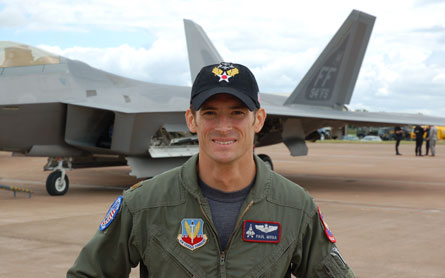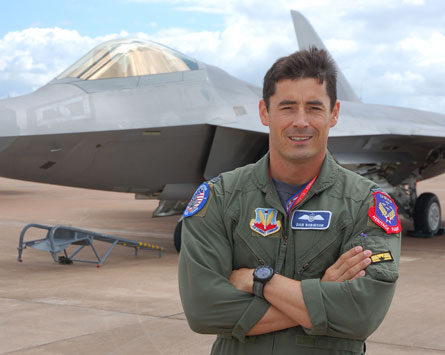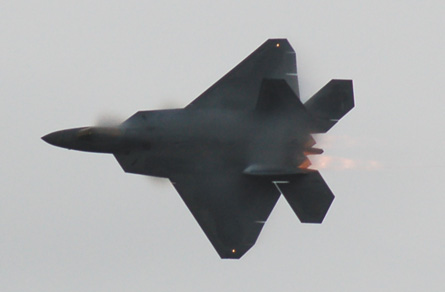Jump to display video ...
While a flypast involving 90 Royal Air Force aircraft and appalling weather conditions grabbed the headlines at the Royal International Air Tattoo on 11 July, the debut appearance of the US Air Force’s Lockheed Martin F-22 Raptor provided the clear display highlight.
Three F-22s landed at RAF Fairford in Gloucestershire on 8 July, following a 7h 45min transit flight from Langley AFB, Virginia. One of the aircraft – flown by demonstration pilot Maj Paul ‘Max’ Moga (below) from the USAF’s 27th Fighter Squadron – is scheduled to fly at RIAT on 13 July, before making an appearance at the Farnborough air show the following day.
 |
|---|
© Craig Hoyle/Flight International |
“Getting over here was flawless,” Moga told Flight International during an interview at RIAT on 11 July. Supported by a McDonnell Douglas KDC-10 tanker, each of the F-22s received fuel 11 times during the sortie – the first transatlantic flight involving the Raptor. This high number was due to a requirement to ensure that each of the stealth fighters had sufficient fuel reserves to be able to divert to a suitable airfield if necessary.
The deployment took place at altitudes of up to the high-20,000ft bracket, said RAF F-22 exchange pilot Flt Lt Dan Robinson, who had the distinction of landing the first Raptor to touch down on UK soil. Also an instructor on the US type, Robinson (below) was formerly a qualified weapons instructor on the RAF’s Panavia Tornado F3 fighter.
 |
|---|
© Craig Hoyle/Flight International |
Demonstration team superintendent Master Sgt Tim Green said: “The three aircraft that flew over were ‘Code One’ when they landed. They were solid airplanes.” The deployment involves around 25 support personnel, as opposed to a core team of two crew chiefs and four specialists who usually support a one-aircraft commitment to air shows in the USA.
 |
|---|
© DRMonk/AirSpace |
Moga performed an approximately 10min display at Fairford, with highlights including several high angle of attack, low-speed manoeuvres, a power loop and a non-conformal loop. Noting that the routine was created as “safe, repeatable and to showcase the F-22’s unique capabilities”, he said it also includes several tactical manoeuvres “familiar to any Raptor pilot”.
 |
|---|
© Craig Hoyle/Flight International |
A slightly revised display routine was also validated at Farnborough on 10 July, with some changes required due to the event’s increased minimum safety ceiling of 500ft.
Following the detachment’s return home after the opening day of Farnborough, Robinson says the 27th FS will in late August participate in a dissimilar air combat exercise to be hosted at a yet-to-be confirmed location in the USA.
The USAF’s F-22 community faces a continued challenge in finding suitable opponents to practice air-to-air combat, with the type’s participation in a recent Cope Thunder exercise in Canada having seen it record a combat success ratio of 144:0. “It’s a very real problem to find a suitable adversary,” says Robinson.
Source: FlightGlobal.com























